Once upon a time, there was a romantic vision of writers treating their bodies terribly. Opiates, pharmaceuticals, alcohol, and cigarettes were an integral part of the tortured writer stereotype.
Elizabeth Barrett Browning was known for her opium addiction. William S.Burroughs was a heroin addict. Then there are the myriad of writers, past and present, with alcohol issues: Hemingway, Bukowski, Fitzgerald, Poe, Bukowski, to name a few…
In the past decade or so, I’ve noticed a changing of the tides. Writers exercise, care about their diets, and employ mindful practices to assist their writing. Additional to this are the exercises and stretches writers can do to help combat the negative side effects of sitting hunched over a computer all day.
Heather Glidden is a Certified Gyrotonic, Gyrokinesis, and Pilates Instructor, and the co-owner of Gyrotonic Tree Town & Pilates Loft Studio in Ann Arbor. She’s also a LitReactor member I met in a science fiction writing class on Litreactor, taught by Kat Howard.
Heather had some fascinating things to say about the common injuries we develop from sitting at our desks typing on a keyboard. She identified some common injuries and strains we suffer from our desk and typing habits:
- Forward head posture — the muscles at the back of your neck get shortened and the muscles in the front of the neck get over-lengthened and weak;
- Slouched spine—this is actually an extension of the forward head posture and is a bit more complicated because your spine should have curves. When you slouch you often put those curves out of their natural balance. But in general this posture tends to create overstretched/strained back muscles and more tightness in the chest;
- Rounded shoulders—which result in tight chest muscles (mainly the pecs) and overstretched muscles between the shoulder blades (trapezius and rhomboids);
- Tight hip flexors—which often correspond to weak hip extensors; and
- Tight hamstrings.
The part I found a little disconcerting is that our body learns this behaviour. Heather explained:
What we are learning with current research is that all of these patterns really have more to do with the nervous system than the muscles themselves. Muscles aren’t very smart. A muscle doesn’t hold itself at a certain length because it is “stuck” there, it does so because the nervous system tells it to. The nervous system adapts based on what it is trained for. So by sitting at a computer all day, you can train all of the patterns that I explained above into your body.
If pain from typing all day isn’t enough to convince you that you need to look after your body, maybe that is! Heather has recommended the following exercises to combat the common injuries she identified.
Forward head posture and slouched spine exercise:
This exercise is done seated.
- Interlace your fingers and put your hands on the back of your head near the base of your skull. Gently press your head backward into your hands while dropping your chin down. You can give a little gentle traction upward with your hands. You should feel the back of your neck lengthen—if you had eyes just under the base of your skull, they would open. As a bonus, this sometimes gives a little chest stretch as well. Release the pressure and repeat several times.
- Start with the same set-up and keep the pressure into your hands as you turn your head slowly side to side. Let your opposite shoulder be heavy so it drops down away from your ear. You should feel a gentle stretch in the side of your neck.
Rounded shoulders exercise:
This exercise is done standing against a wall.
- Stand against a wall and try to feel where your shoulder blades touch the wall. Shrug your shoulders up and feel the shoulder blades move up along the wall, then move your shoulders as far down as they will go and feel your shoulder blades slide down the wall. Then pull your shoulder blades together and then slide them wide apart—back and forth—maintaining contact with the wall.
- Now lift your arms up in front of you like you are prepped for surgery (elbows bent, fingers pointing upward). Slowly open your arms as wide as they will go till you look like someone is telling you to “stick em up!” See if you can open your elbows all the way to the wall. See if your hands can touch the wall at the same time as your elbows. Then see if you can do the exercise while keeping your shoulder blades as far down and as wide as possible.
If that gets easy then reach your arms out straight to the sides (parallel to the floor) with your palms facing forward and your fingers spreading. Do this several times, closing your arms in between.
Tight Hip Flexors and Tight Hamstrings
This exercise is done moving around the room.
- Step forward into a lunge (front leg bent, back leg straight), then step together.
- Alternate sides several times. You can use your hands on your front leg for balance, but try to use your leg strength when you step together. Keep your torso as vertical as possible.
- Lunge your right leg forward and stay there. Put your hands behind your head. Turn your shoulders so you lift your left elbow toward the ceiling and stretch your whole left side, then turn your right elbow toward the ceiling. Go back and forth a few times. Repeat on the other leg.
- Lunge one leg forward. Put your hands behind your head again. Lift your chest and eyes up to the ceiling in an arch, using your hands to support your head. Feel the stretch through the whole front line of your body. Return to vertical. Repeat a few times and then continue on the other side.
- Heather also notes it’s important to remember to keep breathing through these exercises!
Let’s look now to our necks and backs, which are under considerable strain when we hunch over our keyboards to type.
Mimi, from Blissful Body Pilates in Carmichael, California, suggested the following simple rotation and extension exercises that you can do in the comfort and privacy of your house. Mimi holds several different pilates and yoga certifications through BASI and Balanced Body.
She says that the rotation exercise “focuses on rotation of the thoracic spine, and really corrects your computer posture.”
- Lay on your side, with your knees pulled in towards you at a 45 degree angle. Make sure they are stacked on top of each other, with your hips neatly aligned. You can support your head with your hand or a pillow.
- Lift your other arm up towards the ceiling, but keep a bent elbow. The elbow should be pointed towards the ceiling. Your elbow will rotate with your body, following the movement of your spine.
- Breathe in deeply to prepare. Let your body roll slightly towards your front, and let your top knee slide forward a little.
- Turn your bent elbow towards the ceiling, and begin opening up the opposite way, circling your elbow behind you. This will open up the side lung and chest.
- Roll forward again and close your body and chest towards the floor, then roll back and open up the chest again. Your elbow’s still following the movement of your spine here.
When doing this exercise, your gaze and torso should follow your elbow. Do about 4-5 repetitions of this exercise, then switch sides.
Mimi says that this rotation exercise warms the spine up and you can move into an extension exercise.
- Lie face-down on your stomach. You can use a wall to align yourself if you like, keeping the soles of your feet pressing into the wall behind you.
- Bend your elbows, place your hands under your forehead with one hand on top of the other. Rest your head on your hands.
- Breathe in deeply to prepare, and when you exhale, slowly lift your head up with your hands still under your forehead. Make sure you draw in your abdominals to support your lower spine. Lower down slowly.
With this exercise, you shouldn’t feel any pain or tightness in your lower back. Make sure you only go as far as you feel comfortable.
If this feels good for you, and you’d like an extra challenge, you can add in a side bend. Begin the same way lifting up, then start to bend towards your left side, looking towards your left side. Come back to center, and bend to your right size. Lower back down to your starting position.
Do about 4-5 repetitions of this exercise.
Megan Macgregor understands the hazards of sitting at a keyboard for inhumane hours. In a former life, she was a corporate lawyer. She left the profession and became a certified pilates and yoga teacher over 13 years ago, and teaches classes at Body Mind Life in Sydney, Australia.
Megan confirms that our bodies adapt to being seated at our desk for long periods of time, and we should get as much movement in to our daily routines as possible, “The answer is to sit less and move well and much more often.”
Lower back pain is common to not just writers, but anyone who is in an occupation where they sit at a desk all day. Megan says:
For those who live predominantly sedentary lives, for example, the bones and connective tissues and muscles settle through time into the position or positions that we most frequently adopt while sitting or sleeping. Our bodies eventually tighten in areas that best support that seated or curled up sleeping position.
Our spine and ribs become less mobile, hip flexors become shorter and tighter, our gluteus and hamstring muscles are underused and underdeveloped, the connective tissue or fascia in our backs becomes thicker and tighter. That tightness contributes significantly to back pain. Our bodies have adapted to be stationery and seated to our detriment.
Megan’s recommended some exercises below, and suggests dedicating five minutes a day doing these to help your posture and to reduce back pain. “Try each of these exercises after reading this article. You will find that your body feels so good that you'll want to repeat the exercises often. Enjoy!”
I can attest to the fact that these do feel surprisingly good to do and you feel great afterwards!
Bridging
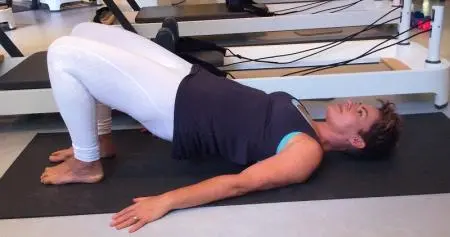
Preparation: Lie on your back on a flat surface with your knees bent, feet flat on the floor about 3 to 4 inches apart.
Allow your back to find its natural shape on the floor, place your arms by your side with your palms up or down depending on how comfortable this is for you.
Moving and Breathing: Breathe in through your nose and breathe out through your mouth in a soft quiet 'ah' a few times. Try to let the breath out be a bit longer in length than the breath in.
Exhale and gently press your lower back (lumbar spine) into the floor. Curl your tailbone towards your pubic bone, your pubic bone towards your navel and roll your bottom and hips up off the floor until you reach the mid-upper back between the shoulder blades. Reach your sit bones to the backs of your knees and soften your rib downwards.
Inhale here and lengthen your neck pressing the back of your head lightly into the floor. Exhale soften your jaw, throat and breastbone and roll your spine all the way back down one centimeter at a time until your spine comes back to the starting position.
NB: This exercise is safe for most people except those with osteoporosis or in the late stages of pregnancy.
Benefits: Back pain inhibits segmental movement of the spine. By gently articulating the spine in bridging you can help the spine and the rib cage to become more mobile. Bridging also improves hamstring strength and hip flexor length.
Arm Arcs with (or without Bridging)
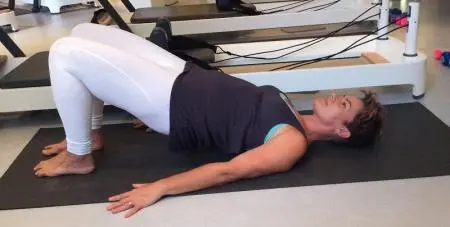
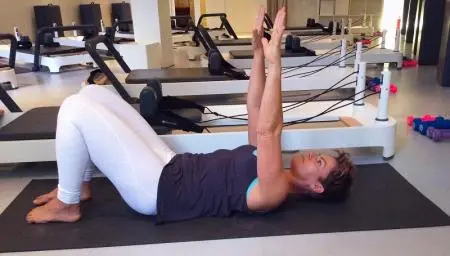
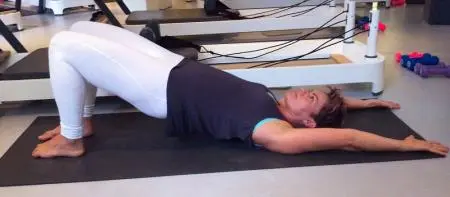
Preparation: As for bridging, lie on your back on a flat surface with your knees bent, feet flat on the floor about 3 to 4 inches apart.
Moving and Breathing: Keeping your ribs still, inhale and float your arms lightly off the floor. Bring your arms only as far overhead as your shoulders will comfortably allow. Exhale to lower your arms back to the floor, opening your collar bones as you press the back of your arms down.
To add to the range of movement, curl up in Bridging then float the arms overhead. As you roll down through the spine, lower the arms to the floor so that your hips and your arms 'land' at the same time.
NB: This exercise is suitable for everyone. If you are in the late ranges of pregnancy though, prop your torso up on firm pillows, a yoga bolster or a Pilates wedge. For those with shoulder injuries or impingement, keep your arms below 90 degrees and only move within the pain free range.
Benefits: Using the arms to move the shoulders in this exercise helps your upper back and shoulders to become more mobile and improves posture.
Book Opening
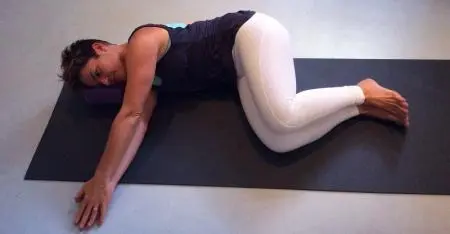
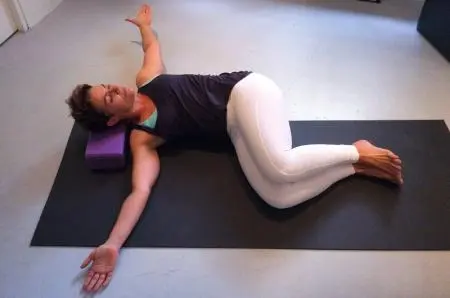
Preparation: Lie on one side and prop your head up on a small rolled up towel, yoga block or cushion, arms out in front of you at a right angle from your body one on top of the other.
Moving and Breathing: Breathe into the space between your shoulder blades, breathe out and start to stretch your top arm up to the ceiling, following the arms with your eyes, breastbone, ribs and spine. Keep the legs bent and in the starting position if you can.
Keep rotating the upper body as far as you can without the front of the shoulder pushing forward. Your top arm may stay up in the air if your chest and upper back are tight. Inhale to reach the arms further apart. Exhale to return to the starting position turning from the rib cage.
If you have very limited range of movement, place cushions or pillows between the top rotating arm and the floor.
NB: This exercise is suitable for almost everyone. If you have stenosis, disc issues or osteoporosis, however, please limit the range of movement by placing firm pillows on the side you are rolling towards.
Benefits: Improves thoracic rotation, a movement of the spine that becomes very restricted after long periods of time sitting at a computer. This exercise also reduces kyphosis/rounding of the upper back by bringing your thoracic spine into extension as well as rotation. You will also find that your shoulder and outer hip mobility improves as well as your posture.
Kneeling Hip Stretch
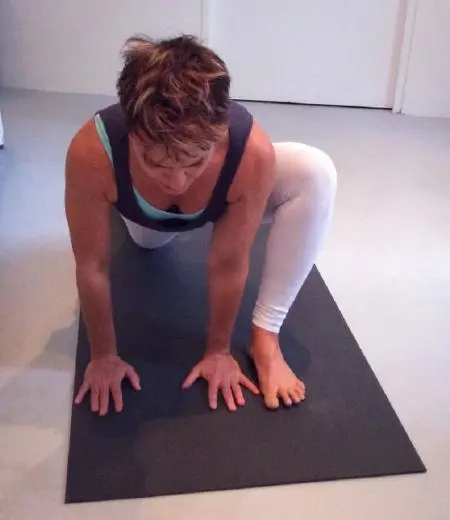

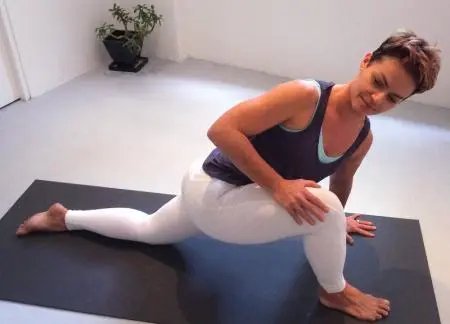
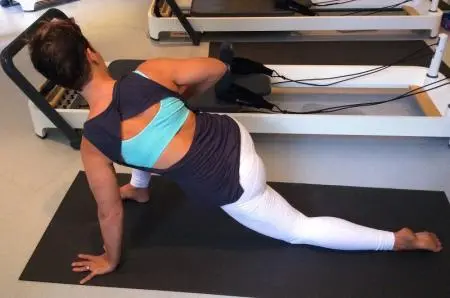
If you spend all day seated your hips will become as tight as steel traps. Tight hip flexors and quadriceps are known to contribute to back pain. This hip opening stretch wil help.
Preparation: Set up in a four point kneeling/quadriped position. Step one foot forward between your hand and heel to toe walk or slide that foot forward until your knee is right above your heel. Slide the back knee as far behind you as you comfortably can and keep the top of the back foot flat on the floor. Keep the hands on either side of the front foot.
Moving and Breathing: Inhale to lift the chest and exhale to lower the chest and pelvis towards the floor. Press the top of the back foot and the front of the back shin into the floor to increase the stretch of the front hip and the engagement of the glutes and hamstrings on the back leg. If your back ankle is uncomfortable, place a firm pillow underneath the back ankle or back knee.
Once you find a stretch that feels deep enough to you, hold and breath for a period of a minute or more on each side.
A deeper variation is to add a twist. Use the same side hand to push the front knee open to the side while you rotate first your navel towards the leg and then deepen the stretch by rotating the chest towards the sky.
NB: This stretch can be uncomfortable for the kneecap or ankle. If you are stiff, the back thigh will be at a 90 degree angle to the front thigh, putting a lot of weight on the kneecap. Support the back knee with a blanket, or place a bolster under the shin, allowing the back knee to be off the floor.
Benefits: This exercise is a deep hip and groin opener that gets right into the hip joint and allows you to open and release your hip flexors (the psoas and the iliacus). Its hip-extending movements, moving the leg behind your body, strengthens your gluteal muscles. This will in turn lead to greater hip mobility and a happier lower back. You may find that it provides some relief from sciatica.
Mermaid/Side Stretch
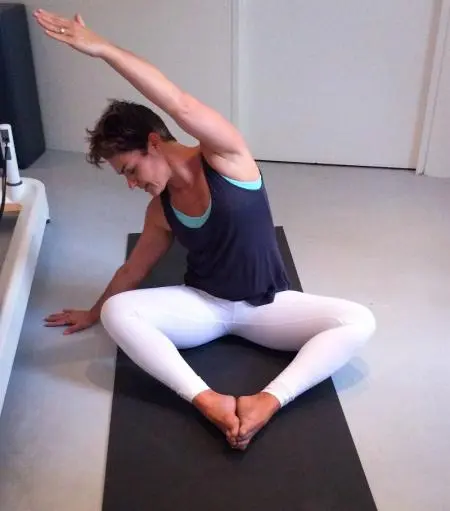
Preparation: In this variation of the Mermaid, sit either with your legs out in front of you in a diamond shape if your hips are tight or side sit with both knees to one side. Make sure that you can feel both sit bones on the mat, your spine is long, waist is long and hands soft by your sides.
Moving and Breathing: Inhale to lengthen and soften the back of the neck. Exhale, press one hand into the floor and lift the other hand over your head. Inhale to round the top ribs upwards and open and separate the top ribs, press the bottom ribs upwards. Ideally the pelvis and the sit bones stay still. Exhale to return to the start position.
If this exercise feels good then you can add a gentle rotation of the top ribs towards the floor.
To make this easier for those of you with tight hips or painful knees you can sit on a firm pillow.
NB: This exercise is suitable for most people. To modify for osteoporosis or shoulder pain, reduce the range of movement and/or place your top hand on your chest or leave it by your side.
Benefits: Lateral flexion or side bending is great for improving spinal mobility, shoulder/wrist alignment and awareness.
Megan ended her advice with the important reminder “if these exercises do not help or make your back pain worse, you may need a thorough assessment of your spine to discover what is causing the pain.”
Rhea Mercado (GDipSc (Exercise Rehab) BHMS ESSAM AEP) is an Accredited Exercise Physiologist and Occupational Rehabilitation Consultant from Sydney, Australia. In her line of work, she deals with a variety of injuries and strain from sitting at a desk and typing at a keyboard.
When asked for some advice on wrist, forearm, and ankle injuries, her general guidelines to minimize the risk of repetitive strain injury (RSI) were:
- Have a good working / ergonomic set up. For the purposes of RSI in the wrists the focus should be on mouse and keyboard set up. The main aim is to minimize excessive & prolonged extension, flexion or deviation of the wrist; and to maintain a “neutral” wrist position.
- Restorative breaks: change to an activity or task that does not use the same muscles as the task you were just doing.
- Pause breaks: have a complete break from working.
- Stretching of muscles that are often used.
Rhea recommended a handy printout of wrist and ankle exercises you can do, from the University of Toronto.
As with all exercise, you should see a health care professional to get the all clear before you begin any new routine. This is particularly pertinent for those who have any pain or niggling before they start a new exercise routine.
Disclaimer: Whilst these exercises are intended to assist readers and writers, anyone who uses them should consider their own medical history, and their own limitations before doing so, and consult a doctor. Any users of exercises in this article assumes the risk of injury from doing the exercises. Litreactor, the author of this article, and the health care professionals quoted herein disclaim any liability in connection with the exercises in this article.

About the author
In a previous life, Jessica worked for 12 years in the legal industry, with her last purely legal role being the corporate counsel for a property management company in Australia. Since then, she’s been the editor for an online literary journal and currently manages a music/tech start-up. She also freelancers as a contract lawyer and content producer, and writes regular columns for Litreactor and Gypsy Girl.
Jessica’s fiction and poetry has appeared in or is upcoming in Andromeda Spaceways Inflight Magazine (Aus), Beware the Dark (UK), Kaleidotrope, Plasma Frequency Magazine, and Pantheon Magazine.
She loves swimming, and like Peter Singer, considers herself a flexible vegan and focuses on the welfarist approach to animal rights.







